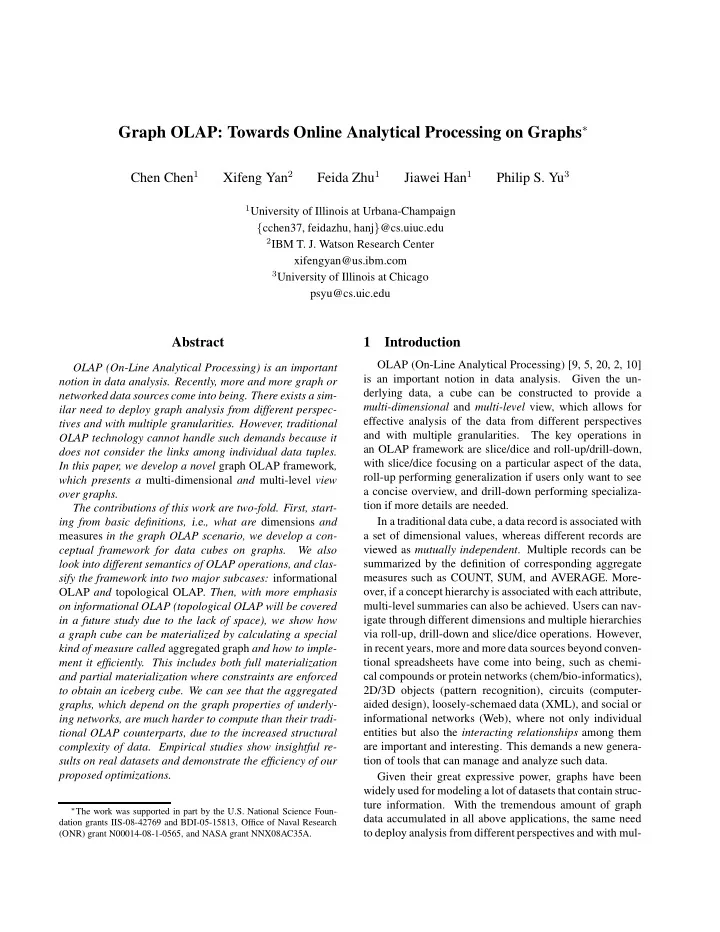

Graph OLAP: Towards Online Analytical Processing on Graphs ∗ Chen Chen 1 Xifeng Yan 2 Feida Zhu 1 Jiawei Han 1 Philip S. Yu 3 1 University of Illinois at Urbana-Champaign { cchen37, feidazhu, hanj } @cs.uiuc.edu 2 IBM T. J. Watson Research Center xifengyan@us.ibm.com 3 University of Illinois at Chicago psyu@cs.uic.edu Abstract 1 Introduction OLAP (On-Line Analytical Processing) [9, 5, 20, 2, 10] OLAP (On-Line Analytical Processing) is an important is an important notion in data analysis. Given the un- notion in data analysis. Recently, more and more graph or derlying data, a cube can be constructed to provide a networked data sources come into being. There exists a sim- multi-dimensional and multi-level view, which allows for ilar need to deploy graph analysis from different perspec- effective analysis of the data from different perspectives tives and with multiple granularities. However, traditional and with multiple granularities. The key operations in OLAP technology cannot handle such demands because it an OLAP framework are slice/dice and roll-up/drill-down, does not consider the links among individual data tuples. with slice/dice focusing on a particular aspect of the data, In this paper, we develop a novel graph OLAP framework , roll-up performing generalization if users only want to see which presents a multi-dimensional and multi-level view a concise overview, and drill-down performing specializa- over graphs. tion if more details are needed. The contributions of this work are two-fold. First, start- ing from basic definitions, i.e. , what are dimensions and In a traditional data cube, a data record is associated with measures in the graph OLAP scenario, we develop a con- a set of dimensional values, whereas different records are ceptual framework for data cubes on graphs. We also viewed as mutually independent . Multiple records can be look into different semantics of OLAP operations, and clas- summarized by the definition of corresponding aggregate sify the framework into two major subcases: informational measures such as COUNT, SUM, and AVERAGE. More- OLAP and topological OLAP . Then, with more emphasis over, if a concept hierarchy is associated with each attribute, on informational OLAP (topological OLAP will be covered multi-level summaries can also be achieved. Users can nav- in a future study due to the lack of space), we show how igate through different dimensions and multiple hierarchies a graph cube can be materialized by calculating a special via roll-up, drill-down and slice/dice operations. However, kind of measure called aggregated graph and how to imple- in recent years, more and more data sources beyond conven- tional spreadsheets have come into being, such as chemi- ment it efficiently. This includes both full materialization cal compounds or protein networks (chem/bio-informatics), and partial materialization where constraints are enforced 2D/3D objects (pattern recognition), circuits (computer- to obtain an iceberg cube. We can see that the aggregated aided design), loosely-schemaed data (XML), and social or graphs, which depend on the graph properties of underly- informational networks (Web), where not only individual ing networks, are much harder to compute than their tradi- entities but also the interacting relationships among them tional OLAP counterparts, due to the increased structural are important and interesting. This demands a new genera- complexity of data. Empirical studies show insightful re- tion of tools that can manage and analyze such data. sults on real datasets and demonstrate the efficiency of our proposed optimizations. Given their great expressive power, graphs have been widely used for modeling a lot of datasets that contain struc- ture information. With the tremendous amount of graph ∗ The work was supported in part by the U.S. National Science Foun- data accumulated in all above applications, the same need dation grants IIS-08-42769 and BDI-05-15813, Office of Naval Research to deploy analysis from different perspectives and with mul- (ONR) grant N00014-08-1-0565, and NASA grant NNX08AC35A.
Recommend
More recommend